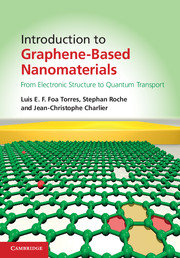Book contents
- Frontmatter
- Contents
- Preface
- 1 Introduction to carbon-based nanostructures
- 2 Electronic properties of carbon-based nanostructures
- 3 Quantum transport: general concepts
- 4 Klein tunneling and ballistic transport in graphene and related materials
- 5 Quantum transport in disordered graphene-based materials
- 6 Quantum transport beyond DC
- 7 Ab initio and multiscale quantum transport in graphene-based materials
- 8 Applications
- Appendix A Electronic structure calculations: the density functional theory (DFT)
- Appendix B Electronic structure calculations: the many-body perturbation theory (MBPT)
- Appendix C Green's functions and ab initio quantum transport in the Landauer–Büttiker formalism
- Appendix D Recursion methods for computing the DOS and wavepacket dynamics
- References
- Index
7 - Ab initio and multiscale quantum transport in graphene-based materials
Published online by Cambridge University Press: 05 February 2014
- Frontmatter
- Contents
- Preface
- 1 Introduction to carbon-based nanostructures
- 2 Electronic properties of carbon-based nanostructures
- 3 Quantum transport: general concepts
- 4 Klein tunneling and ballistic transport in graphene and related materials
- 5 Quantum transport in disordered graphene-based materials
- 6 Quantum transport beyond DC
- 7 Ab initio and multiscale quantum transport in graphene-based materials
- 8 Applications
- Appendix A Electronic structure calculations: the density functional theory (DFT)
- Appendix B Electronic structure calculations: the many-body perturbation theory (MBPT)
- Appendix C Green's functions and ab initio quantum transport in the Landauer–Büttiker formalism
- Appendix D Recursion methods for computing the DOS and wavepacket dynamics
- References
- Index
Summary
This chapter illustrates the several possible computational approaches that can be used towards a more realistic modeling of disorder effects on electronic and transport properties of carbon-based nanostructures. Multiscale approaches are first presented, combining ab initio calculations on small supercells with tight-binding models developed from either a fitting of ab initio band structures, or a matching between conductance profiles with a single defect/impurity. Chemical doping with boron and nitrogen of carbon nan-otubes and graphene nanoribbons is discussed in detail, as well as adsorbed oxygen and hydrogen impurities for two-dimensional graphene, being both of current fundamental interest. Finally, fully ab initio transport calculations (within the Landauer–Büttiker conductance framework) are discussed for nanotubes and graphene nanoribbons, allowing for even more realism, albeit with limited system sizes, in description of complex forms of edge disorder, cluster functionalization or nanotube interconnection.
Introduction
In the following sections, disordered and chemically doped carbon nanotubes and graphene nanoribbons are explored. The main scientific goal consists in illustrating how defects and impurities introduce resonant quasi-localized states at the origin of electron–hole transport asymmetry fingerprints, with the possibility of engineering transport (or mobility) gaps. Several multiscale approaches are described to develop various tight-binding models from first-principles calculations. A first technical strategy (illustrated on boron-doped nanotubes, Section 7.2.2) consists in designing a tight-binding model by fitting the ab initio band structures. Such an approach is used to describe doped metallic nanotubes, but actually ceases to be accurate for graphene nanoribbons, owing to complex screening effects introduced by edges.
- Type
- Chapter
- Information
- Introduction to Graphene-Based NanomaterialsFrom Electronic Structure to Quantum Transport, pp. 232 - 299Publisher: Cambridge University PressPrint publication year: 2014



